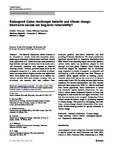Endangered Quino checkerspot butterfly and climate change: Short-term success but long-term vulnerability?
| dc.contributor.author | Parmesan, C | en |
| dc.contributor.author | Williams-Anderson, A | en |
| dc.contributor.author | Moskwik, M | en |
| dc.contributor.author | Mikheyev, AS | en |
| dc.contributor.author | Singer, MC | en |
| dc.date.accessioned | 2017-10-29T18:52:17Z | |
| dc.date.available | 2017-10-29T18:52:17Z | |
| dc.date.issued | 2015-04-01 | en |
| dc.identifier.issn | 1366-638X | en |
| dc.identifier.uri | http://hdl.handle.net/10026.1/10112 | |
| dc.description.abstract |
The butterfly Euphydryas editha is known to be vulnerable to climate events that exacerbate natural phenological asynchrony between insect and hosts. In prior work, populations of E. editha have been more persistent at high latitudes and high elevations than in the south and at low elevations, consistent with response to observed warming climate. However, poleward range shifts by the endangered subspecies E. e. quino are blocked by urbanization and range shifts to higher elevation may require host shifts. Prior studies were inconclusive as to whether elevational and host shifts were already occurring. Here, we re-evaluate this scenario with new evidence from molecular genetics, host-choice behaviour and field recording of butterfly distribution. We found a statistically significant upward shift in population distribution since 2009. Insects in the expanding region were neither genomic outliers within Quino nor specifically adapted to their principal local host genus, Collinsia. These diverse data collectively support the hypothesis that an elevational range expansion is already in progress, accompanied and facilitated by a shift of principal host from Plantago to Collinsia. Quino appears resilient to warming climate. However, projections indicate that most or all of Quino’s current range in the USA, including the new high elevation expansion, will become uninhabitable. Our most frequent projected future range (circa 2050) is c. 400 km northward from current populations, hence conservation of Quino may eventually require assisted colonization. For now, Critical Habitat (sensu Endangered Species Act) has been designated at sites around the new upper elevational limit that were not known to be occupied. Designating Critical Habitat outside the historic range is a pioneering response to climate change. This politically challenging, non-traditional, climate change-oriented conservation effort exemplifies flexible thinking needed for species vulnerable to climate change. | en |
| dc.format.extent | 185 - 204 | en |
| dc.language.iso | en | en |
| dc.title | Endangered Quino checkerspot butterfly and climate change: Short-term success but long-term vulnerability? | en |
| dc.type | Journal Article | |
| plymouth.issue | 2 | en |
| plymouth.volume | 19 | en |
| plymouth.publication-status | Published | en |
| plymouth.journal | Journal of Insect Conservation | en |
| dc.identifier.doi | 10.1007/s10841-014-9743-4 | en |
| plymouth.organisational-group | /Plymouth | |
| plymouth.organisational-group | /Plymouth/Faculty of Science and Engineering | |
| plymouth.organisational-group | /Plymouth/REF 2021 Researchers by UoA | |
| plymouth.organisational-group | /Plymouth/REF 2021 Researchers by UoA/UoA07 Earth Systems and Environmental Sciences | |
| dc.identifier.eissn | 1572-9753 | en |
| dc.rights.embargoperiod | Not known | en |
| rioxxterms.versionofrecord | 10.1007/s10841-014-9743-4 | en |
| rioxxterms.licenseref.uri | http://www.rioxx.net/licenses/all-rights-reserved | en |
| rioxxterms.type | Journal Article/Review | en |


